|
|
| |
ITALY
VENICE
HISTORY, LANDMARKS, MUSEUMS AND GALLERIES
History
The historical origins of Venice as an inhabited settlement begin in the 5th century at the time of the Barbarian invasion of Italy. The local population of some of the regions in North West Italy fled to the marshlands by the coast of the Adriatic Sea in order to avoid being harmed by the Barbarian invasions. The marshlands proved to be a good natural defence against invading forces so the people settled there permanently and in the 6th century formed a loose federation which laid the foundations of what was later to become the great city state of Venice.
 Photo PKG
The history of Venice during medieval times was in many ways the golden era of Venetian history. Prior to the first navigation of the Cape of Good Hope, the only route connecting Europe and Asia passed through the Mediterranean and Adriatic Seas meaning that Venice was well placed along a major trade route. This had great implications for the economy of Venice which thrived at this time. Venice had become a great maritime power in the Adriatic Sea by the 11th century which meant it was strong enough to levy taxes on all goods passing through the area at that time. The crusades which lasted from the 11th to the 13th century also ensured a steady flow of human traffic through Venice at this time which brought along with it obvious economic benefits. During the 3rd Crusade, the Duke of Venice actually took a leading role and ransacked Constantinople during the campaign bringing back many treasures to the city of Venice.
Although the artistic and architectural benefits of the renaissance in Italy were felt in Venice, the 15th century was a time of economic and military decline for Venice. During the 15th century the power of the Ottoman Turkish Navy began to contest the hegemony that Venice had hitherto enjoyed in the Adriatic Sea and eventually Venice as a maritime power was weakened due to the Ottoman capture of several Adriatic territories that had been under the control of Venice. At the same time the navies of the great European powers had discovered how to navigate to Asia passing the Cape of Good Hope which meant their reliance on the Mediterranean and Venice had diminished.
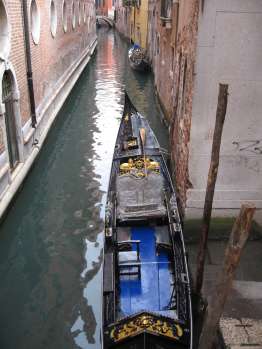 Photo PKG
The 18th and 19th Centuries were a time of Turmoil for Venice, as were they for much of Europe due to the wars that engulfed the continent. Venice was briefly controlled by the French and the Austrians before joining a unified Italy in 1866 after some initial resistance.
Piazza San Marco (St Mark's Square)
Piazza San Marco is the principal square of Venice, Italy. As the central landmark and gathering place for Venice, Piazza San Marco is extremely popular with tourists, photographers, and Venetian pigeons.
The Piazza originated in the 9th century as a small area in front of the original St Mark's Basilica. It was enlarged to its present size and shape in 1177, when the Rio Batario, which had bounded it to the west, and a dock, which had isolated the Doge's Palace from the square, were filled in. The rearrangement was for the meeting of Pope Alexander III and the Emperor Frederick Barbarossa.
The Piazza has always been seen as the centre of Venice. It was the location of all the important offices of the Venetian state, and has been the seat of the archbishopric since the 19th century. It was also the focus for many of Venice's festivals. It is a greatly popular place in Italy even today.
The Basilica di San Marco (St. Mark's Basilica)
St. Mark's Basilica, the cathedral of Venice, is the most famous of the city's churches and one of the best known examples of Byzantine architecture. It lies on St Mark's Square (in the San Marco sestiere or district) adjacent and connected to the Doge's Palace. Originally it was the "chapel" of the Venetian rulers, and not the city's cathedral. Since 1807 it has been the seat of the Patriarch of Venice, archbishop of the Roman Catholic Archdiocese of Venice. For its opulent design, gilded Byzantine mosaics, and its status as a symbol of Venetian wealth and power, from the 11th century on the building was known by the nickname Chiesa d'Oro (Church of gold).
The Canale Grande (Grand Canal) 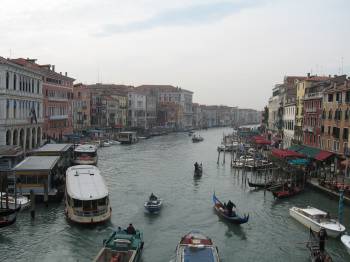 Photo PKG
The Grand Canal is the main aquatic thoroughfare in central Venice. The S-shaped waterway follows an ancient riverbed from the Tronchetto parking island, the Piazzale Roma transit center, and the Santa Lucia railroad station station to Piazza San Marco and St. Mark's Basin. The canal is about 4 km or 2.5 miles long, with a width that varies from 30 to 70 meters (98 to 230 feet).
The Ponte di Rialto (Rialto Bridge)
The Rialto Bridge has been the main pedestrian crossing between the two banks of the Grand Canal since 1591. In fact, it was the only bridge across the Canale Grande until a predecessor to today's Accademia Bridge was built in 1854.
Santa Maria della Salute
Santa Maria della Salute is situated near the mouth of the Grand Canal. The massive eight-sided building sits on more than 100,000 wooden pilings. The church is full of Marian symbolism - the great dome represents her crown, the cavernous interior her womb, the eight sides the eight points on her symbolic star.
The altarpiece of the Baroque high altar, designed by Longhena himself, is a Byzantine Madonna and Child of the 12th or 13th century. Tintoretto contributed Marriage at Cana in the great sacristy, which includes a self-portrait and is considered one of his best works.
The most represented artist is Titian, who painted St Mark enthroned with SS Cosmas, Damian, Sebastian and Roch, the altarpiece of the great sacristy, as well as ceiling paintings of David and Goliath, Abraham and Isaac and Cain and Abel, and eight tondi of the Doctors of the Church and the Evangelists, all in the great sacristy, and Pentecost in the nave.
San Michele Cemetery
The island of San Michele, located in the lagoon close to Venice, has been the city's cemetery (cimitero) since the early nineteenth century. As Venice is an island community, it's not really surprising that its graveyard is also an island, although the notion may seem odd at first. Formerly two islands, which are now joined together, the Isola di San Michele (St. Michael) is dedicated to the dead, and is occupied only by churches and by long ranks of tombs.
Murano
It lies about a mile north of Venice and is famous for its glass making. Murano’s glassmakers held a monopoly on quality glassmaking for centuries, developing or refining many technologies including crystalline glass, enameled glass (smalto), glass with threads of gold (aventurine), multicolored glass (millefiori), milk glass (lattimo), and imitation gemstones made of glass. Today, the artisans of Murano are still employing these century-old techniques, crafting everything from contemporary art glass and glass jewelry to Murano glass chandeliers and wine stoppers.
 Photo PKGToday, Murano is home to the Museo Vetrario or Glass Museum in the Palazzo Giustinian, which holds displays on the history of glassmaking as well as glass samples ranging from Egyptian times through the present day.
Burano
Burano is situated 7 kilometers from Venice, a short 40 minute trip by Venetian motorboats, "vaporetti".
The Lido di Venezia, a beach resort on the strip of land that separates the Venetian Lagoon from the Adriatic Sea.
Burano rose in importance only in the 16th century, when women on the island began making lace with needles. The lace was soon exported across Europe, but decline began in the 18th century and the industry did not revive until 1872, when a school of lacemaking was opened. 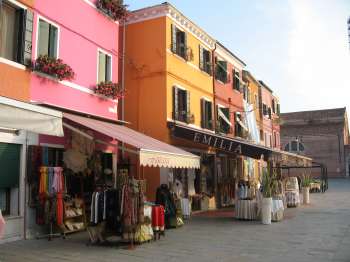 Photo PKGBurano is also known for its small, brightly-painted houses, popular with artists. Other attractions include the Church of San Martino, with a campanile, the Oratorio di Santa Barbara and the Museum and School of Lacemaking.
Lido
The Lido di Venezia is a long, narrow island that acts as a barrier between the Venetian Lagoon and the sea. Much of the island is taken up by 19th and 20th Century villas, some of which have been converted to hotels. The Venice film festival takes place at the Lido every September. 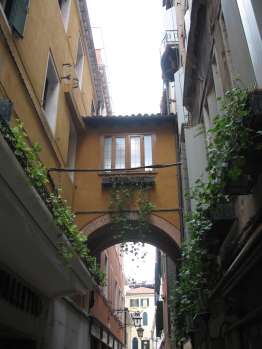 Photo PKG
At least half the Adriatic side of the island is constituted by a sandy beach, much of which belongs to the various hotels that house the summer tourists. These include the renowned Excelsior and the Des Bains, setting for Thomas Mann's classic novel Death in Venice. These beaches are private, though towards the northern and southern ends of the island there are two enormous public beaches.
| |
|
Festivals & Events
Vinum Bonum
This is a very special period in Valley Veneggia just south of Bolzano and just north of the upper tip of Lake Garda. For the entire month of August there are musical concerts held in a variety of the 27 wine-gowing 'cantinas' in the valley selected by a governing board for the high quality of the wines they produce. The tastings all begin at 4:30 in the afternoon and conclude at 7:00 PM and are only held on Tuesdays, Thursdays and Fridays.
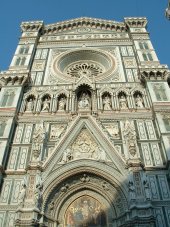 St. Maria del Fiore, Florence
Photo: BPG
International Piano Festival - Amalfi
July and August
The Chiostro del Paradiso is the setting for concerts by Italian and foreign pianists who alternate playing every Friday.
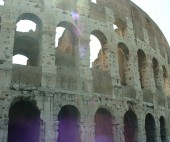 The Colosseum, Rome
Photo: BPG
MUSICAL WEEKS
Siena
August
Accademia Musicale Chigiana
Via di Città 89 - 53100 Siena
Tel. 39 0577 46152
Fax 39 0577 288124
Spoleto
June - July
Associazione Festival dei Due Mondi
Piazza Duomo 8 - 06049 Spoleto
Tel. 39 0743 220320 or 45028 or 40619
Fax 39 0743 220321
e-mail: spoletofestival@krenet.it
Torre del Lago Festival Pucciniano
August
Torre del Lago Puccini
Piazzale Belvedere 4 - 55048 Viareggio (Lucca)
Tel. 39 0584 350562
Fax 39 0584 350277 or 350562
Umbria Umbria Jazz
July
"Associazione Umbria Jazz"
P.O. Box 228 - 06100 Perugia
Tel. 39 075 62432
Fax 39 075 5730053
Viterbo Baroque Music Festival
August
Palazzo Santoro - Piazza Verdi 4/A 01100 Viterbo
Tel.39 0761 326666
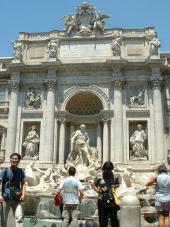 The Trevi Fountain, Rome
Photo: BPG
Ivrea Carnival
Early January
(lasts for 5 days)
In 2001 the carnival celebrated its 194th edition, but the area had started celebrating the events as early as the 1600s. The fight for liberty, when the men of Ivrea "expelled" the Marquis of Monferrato, is recreated with the Battles of the Oranges, which substitute stones. To make it fun there are several orange throwing "teams", all sporting colorful uniforms. The Carnival also has a lot of parties, food events and music.
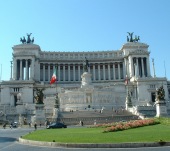 Vittorio Emanuele Monument, Rome
Photo: BPG
San Gennaro - Naples
September
San Gennaro, patron saint and protector of Napoli, stands for many as a symbol of the city itself, and his festival is one of the most passionately celebrated in all of Italy.
The festival ideally culminates in the miracle of the liquefaction of the blood of San Gennaro, which takes place every year more or less on the date of the festival. Many accept the divine nature of the event, and it is incontestable that the blood liquefies, but experts obviously differ on why or how this happens.
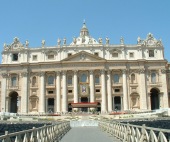 St. Peter's Basilica, Rome
Photo: BPG
Easter Sunday Florence
The annual 'holy fire' during Holy Week, is started with historical shards of the Holy Sepulchre, and is lit in the Church of SS Apostoli and transported to the Duomo, where the archbishop of the city lights the sacred 'Colombina' rocket with it during the Easter Mass. The rocket travels out of the Duomo along a wire, sets fire to the huge array of fireworks attached to the ICARRO and returns back into the church the way it came.
The celebration of the ceremony still bears a strong resemblance to the way in which it has been celebrated for centuries. On the morning of the day the Carro, pulled by two white oxen, leaves from Via del Prato for the Piazza del Duomo, accompanied by costumed revellers and various city officials and clerical representatives.
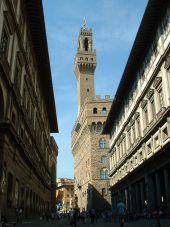 Palazzo Vecchio, Florence
Photo: BPG
The Palio delle Contrade,
Siena
July
A banner, decorated with an image of the Virgin Mary, is presented to the winner of a horse race around the Siena's Piazza del Campo. Competitors come from each one of the 17 districts of the city.
The race consists of bareback riders making three circuits of the main square and is over in 90 seconds. But it is preceded by 5 hours of flag throwing acrobatics around the main square.
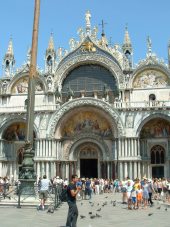 St. Marco Basilica, Venice
Photo: BPG
Viareggio
February - March
Every year The Viareggio Carnival is the most spectacular in Italy, and is known world-wide. The people of Viareggio begin preparing the huge papier-maché puppets in hangar-like buildings by the sea. The figures satirise public and political figures; making them and setting them atop the floats requires considerable technical skill as well as creativity and imagination.
The voluminous floats parade around Viareggio competing for the finest float award from 2.30pm until 9pm on the following dates: 11, 18, 25, 27 Feb and 4 March, each one carrying about 200 people in costume, as well as the huge moving, Trojan horse-like puppets, which hold people inside to manoeuvre the weights, counter-weights and levers that prevent them from toppling over.
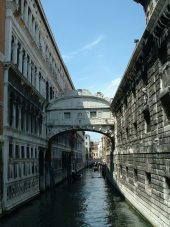 The Bridge of Sighs, Venice
Photo: BPG
|
|
|